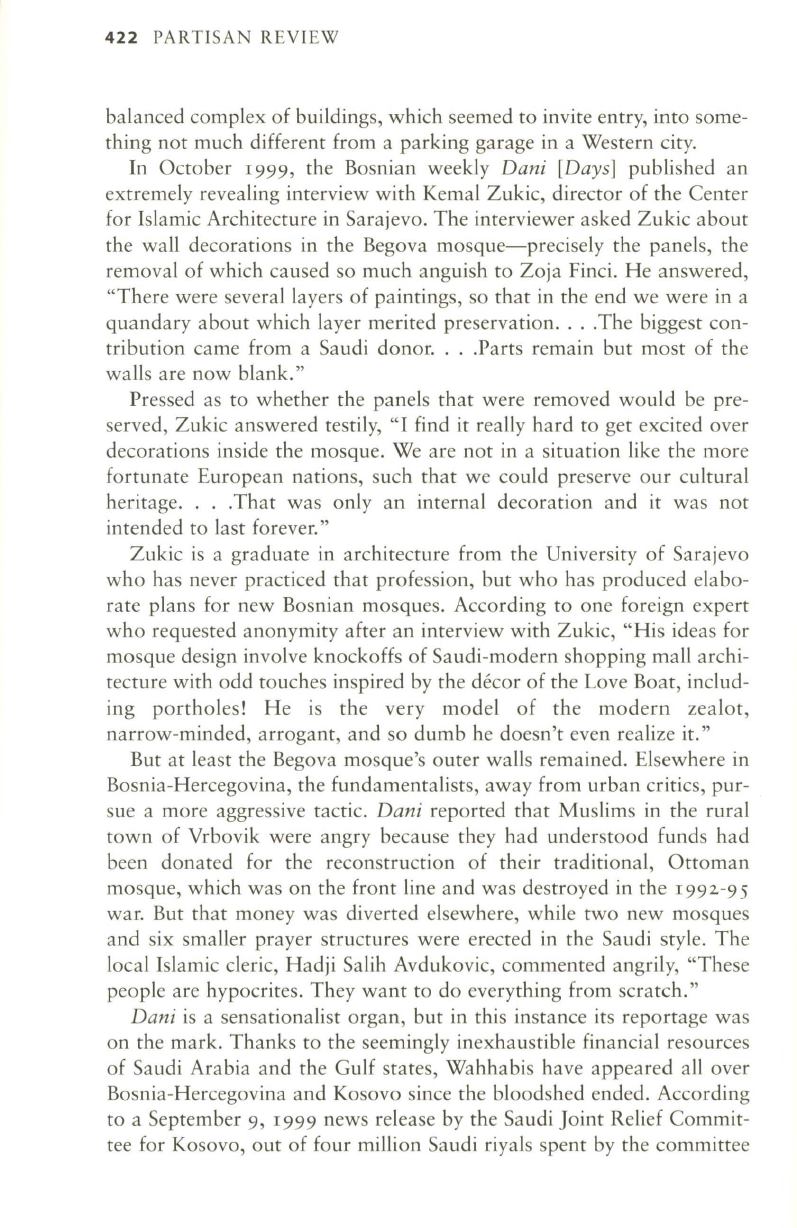
422
PARTISAN REVIEW
balanced complex of buildings, which seemed to invite entry, into some–
thing not much different from a parking garage in a Western city.
In October
1999,
the Bosnian weekly
Dani [Days]
published an
extremely revealing interview with Kemal Zukic, director of the Center
for Islamic Architecture in Sarajevo. The interviewer asked Zukic about
the wall decorations in the Begova mosque-precisely the panels, the
removal of which caused so much anguish to Zoja Finci. He answered,
"There were several layers of paintings, so that in the end we were in a
quandary about which layer merited preservation....The biggest con–
tribution came from a Saudi donor....Parts remain but most of the
walls are now blank."
Pressed as to whether the panels that were removed would be pre–
served, Zukic answered testily, "I find it really hard to get excited over
decorations inside the mosque. We are not in a situation like the more
fortunate European nations, such that we could preserve our cultural
heritage. . . .That was only an internal decoration and it was not
intended to last forever."
Zukic is a graduate in architecture from the University of Sarajevo
who has never practiced that profession, but who has produced elabo–
rate plans for new Bosnian mosques. According to one foreign expert
who requested anonymity after an interview with Zukic, "His ideas for
mosque design involve knockoffs of Saudi-modern shopping mall archi–
tecture with odd touches inspired by the decor of the Love Boat, includ–
ing portholes! He is the very model of the modern zealot,
narrow-minded, arrogant, and so dumb he doesn't even realize it."
But at least the Begova mosque's outer walls remained. Elsewhere in
Bosnia-Hercegovina, the fundamentalists, away from urban critics, pur–
sue a more aggressive tactic.
Dani
reported that Muslims in the rural
town of Vrbovik were angry because they had understood funds had
been donated for the reconstruction of their traditional, Ottoman
mosque, which was on the front line and was destroyed in the
1992-95
war. But that money was diverted elsewhere, while two new mosques
and six smaller prayer structures were erected in the Saudi style. The
local Islamic cleric, Hadji Salih Avdukovic, commented angrily, "These
people are hypocrites. They want to do everything from scratch."
Dani
is a sensationalist organ, but in this instance its reportage was
on the mark. Thanks to the seemingly inexhaustible financial resources
of Saudi Arabia and the Gulf states, Wahhabis have appeared all over
Bosnia-Hercegovina and Kosovo since the bloodshed ended. According
to a September
9, 1999
news release by the Saudi Joint Relief Commit–
tee for Kosovo, out of four million Saudi riyals spent by the committee


